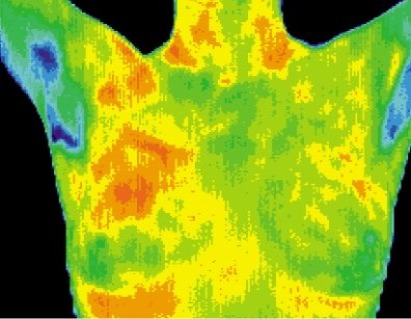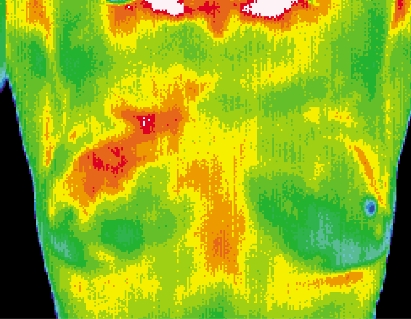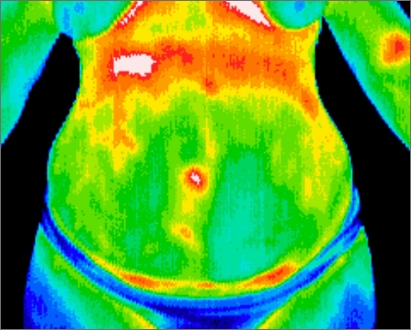Thermography is a unique, non-invasive screening used to detect abnormal activity and inflammation in the body that offers increased opportunity for early detection and intervention.
Services
Thermography
• No Pain
• No Radiation
• No Compression
• No Doctor Referral Needed
• Reports completed by MDs
Let us help you visualize your health.
One of a Kind
Thermography is a clinical imaging procedure used to detect and monitor a number of diseases and physical injuries. Thermal patterns indicate areas of reduced or increased activity, signifying changes of inflammatory activity or abnormal blood flow which can indicate disease or dysfunction. By visualizing thermal abnormalities present in the body, such as lymphatic congestion, pain, metabolic processes, and physiological (or functional) changes over time, thermography can help detect these abnormalities at their earliest stages.
Safe & Painless
Thermal images are taken using a digital thermal infrared camera without contact to the body, making screenings safe, comfortable, painless, and free of harmful radiation.
Proven & Reliable
Clinical trials have shown that thermography significantly augments the long-term survival rates of its recipients by as much as 61%. And when used as part of a multimodal approach, 95% of all early-stage cancers may be detected. No one breast test is 100% accurate, so it is important to consider a multimodal approach (used along with clinical examination, mammography, or ultrasound). This valuable health information can assist you in being proactive about your health.
Gain insight into your health.
Seeing your body’s function is the first step to early detection. We can help.
- Breasts & Underarms
- Breast Baseline
- Women’s Health Check
- Full Body
- Abdomen
- Cardiovascular
- Head & Neck
- Immune System
- Pain & Injuries
- Spine & Musculoskeletal
Breasts & Underarms
Breast thermography’s ability to detect a precancerous state or signs of cancer in the breast at an early stage lies in its unique capability of monitoring the temperature variations and blood vessel alterations produced by the earliest changes in tissue physiology often before a lump even presents itself and is detectable by other structural tests.
All women can benefit from thermography and it can be especially helpful for women with dense breast tissue. Unlike mammograms which have a difficult time seeing through dense tissue, it poses no issue for thermography since it is not a structural screening. It can also help identify fibrocystic activity and lymph congestion, both very common in women. It takes years for tumors to grow large enough to be seen on a structural test or to be palpable, hence the earliest possible indication of abnormality is essential to early intervention.
This may be valuable for:
• Dense breasts
• Fibrocystic breast tissue
• Reconstructed breasts
• Mastectomy
• Breast implants
Breast Thermography Resources:




Breast Baseline Explanation
Every woman has a unique thermal pattern that should stay the same throughout her life. Since thermography monitors subtle changes over time, an accurate and stable baseline is required for the breast region. This is established by your initial scan providing a baseline image of your “thermal signature” which is then compared to your subsequent scan in three months. If your thermal patterns remain unchanged, your stable baseline is established and an annual breast screening will be recommended.
Initial scan + 3 month scan = stable baseline for annual comparisons



Women’s Health Check
Our Women’s Health Check Thermography was designed with women’s needs in mind. By providing thermal findings related to breast, OB-GYN, thyroid, endocrine, visceral, and autonomic (nerve) status, it provides a holistic view of your overall health and future risk levels.
The easy-to-understand report specifically identifies findings related to estrogen dominance, symptoms of adrenal fatigue or insufficiency, thyroid dysfunction, and hormone imbalance. Using a color-coded slider indicating associated risk levels, your report will assist you and your practitioner in taking positive action to improve ‘women’s wellness’ whether through lifestyle changes, holistic treatments, or medical intervention.
This may be valuable for:
• Breast health
• Organ dysfunction
• Thyroid
• Hormone imbalances
Women’s Health Check Resources:




















Full Body
Full body thermography offers a comprehensive head-to-toe view of the entire body, which will provide you with abundant information. Thermography has many applications for full-body imaging such as detecting and monitoring a number of diseases, physical injuries, and overall inflammation in the body. It can help to visualize your pain when other tests fail to find the cause.
Full-body imaging may provide you with new health information and/or help monitor illnesses you may be dealing with. It’s an excellent first screening step that may help you decide if further investigation or treatments may be warranted. Not only are we looking for areas of concern but the screening can also help confirm your healthy lifestyle habits are benefiting you.
This may be valuable for:
• Comprehensive head-to-toe imaging
• Monitoring whole body health
• Proactive approach
• Inflammation
Full Body Resources:













Abdomen
Abdominal thermography can assist in detecting and monitoring a variety of issues involving our vital organs and systems such as inflammation or dysfunction with the kidneys, liver, colon, digestive system, major muscle groups, spine and discs, urinary system, and female reproductive organs.
Often, we are able to pinpoint the origin of pain patterns that frequently stem from nerve impingement, trigger points in the muscles, or myofascial dysfunction. All of this information is valuable in helping you decide how to move forward in treating various conditions.
This may be valuable for:
• Digestive disorders
• Unexplained pain
• Organ dysfunction
• Low back pain
• Colon inflammation
Abdominal Thermography Resources:








Cardiovascular
Undetected inflammation in the carotid arteries can lead to stroke and heart disease. Thermography can detect this inflammation that could be caused by elevated C-reactive protein (CRP) levels, blockages or narrowing of the arteries, and plaque buildup.
Thermography may also detect phlebitis (inflammation of a vein), DVT (deep vein thrombosis), and common varicose veins. Identifying these areas of concern can facilitate targeted treatment and prevention of more serious issues.
This may be valuable for:
• Cardiovascular concerns
• Stroke prevention
• Family history
• Vascular inflammation
Cardiovascular Resources:








Head & Neck
Head and neck thermography includes the thyroid, carotid arteries, dental region, TMJ, lymph glands, sinus cavities, cervical spine and muscles and can help to detect conditions that are difficult to diagnose with traditional tests. It does not include the brain—due to the skull, thermal patterns are undetectable.
Some of these issues include dental infection, TMJ dysfunction, inflammation in the carotid arteries, thyroid dysfunction, facial paralysis (Bell’s Palsy), and neurogenic flares that may indicate autoimmune disorders such as fibromyalgia. Contributing factors can range from food allergies, dental pathology, chronic stress, heavy metal toxicity, hormone imbalances, systemic illness, and more. Often, the reports indicate thyroid dysfunction even if a client has been told they are ‘normal.’ Many women remain undiagnosed because they have never had a complete lab panel of thyroid hormones. Their thermography results prompt them to take further action in investigating this issue.
This may be valuable for:
• Carotid arteries
• Thyroid dysfunction
• Dental concerns
• Headaches or neck pain
Head & Neck Resources:


















Immune System Dysfunction
With immune health on everyone’s mind, you can now gain additional insight about your immune health status after viral infection or post-vaccine through our graded health assessment. Disorders can either cause abnormally low activity or over-activity of the immune system. Immune deficiency diseases decrease the body’s ability to fight invaders, causing vulnerability to infections. In cases of immune system overactivity, the body attacks and damages its own tissues (autoimmune diseases). Autonomic diseases (the presenting sign of autoimmune disorders) are the primary cause of the most vulnerable people being seriously affected by Covid-19. Those with chronically activated autoimmune systems are at increased risk.
The Immune Health Check (IHC) has the ability to evaluate and monitor many of the markers relating to autonomic dysfunction and other burdens on the health system making this test an important preventative and monitoring strategy. The report is designed to help you and your healthcare provider take a proactive and preventative approach to monitoring, maintaining, and improving immune health and well-being. The IHC report does not replace a PCR test or diagnose Covid-19.
Immune System Resources:













Pain & Injuries
Thermography can be used to detect specific patterns of pain and inflammation due to injuries, circulation and nerve disorders, fibromyalgia, and Complex Regional Pain Syndrome (CRPS). It may also detect the source of pain and inflammation surrounding bone fractures, sports or automobile injuries, entrapped nerves, muscular trigger points, and sympathetic irritation. Discovering the source of the problem allows for more specific intervention and treatment and helps prevent injuries by detecting areas of concern or weakness that need attention.
This may be valuable for:
• Pain and injury issues
• Injury prevention
• Origin of pain
• Inflammation
Pain & Injury Resources:








Spine & Musculoskeletal
Using thermography to take images of the spine and musculoskeletal regions can help detect abnormal thermal patterns of inflammation that cause pain, trigger points, and identify areas that may be prone to injury. In particular, athletes are exposed to physical stress in training and competition making overuse and so-called ‘minor traumas’ very frequent; therefore, earlier detection of compromised areas is critical in avoiding more serious injuries.
However, even for the average person, overuse and repetition can cause areas of pain and discomfort. Thermography may help to identify the origin which may not be the area of actual pain. For example, an entrapped nerve in the neck may cause numbness or tingling into the arm or hand.
This may be valuable for:
• Athletes
• Prevention of sports injuries
• Origin of pain
• Spine & nerve disorders
Orthopedic Thermography Resources:




Here’s how it works.
We are with you every step of the way.

Explore thermography pricing and packages.
Breasts &
Underarms
$249
(20-40 minutes)
Includes both breasts, underarm lymphatic region, and upper back.
Breast
Baseline Package
$468
(20-40 minutes)
Includes your initial and 3-month follow up thermography appointments.
Women’s
Health Check
$399
(40 minutes)
Includes both breasts, abdomen, thyroid, carotids, head & neck.
Breasts & Abdomen
(or any 2 regions)
$329
(20-40 minutes)
Choose two regions: breasts, head & neck, abdomen, arms, or legs.
Half Body
$399
(40 minutes)
Includes everything but the legs and feet.
Full Body
$489
(60 minutes)
Includes the entire body including the breast region for female clients.
Breast Thermography & Ultrasound Combo
$499
(60-80 minutes)
Includes your initial breast thermography & ultrasound appointment.
Thermography Women’s Health Check & Breast Ultrasound
$649
(80 minutes)
Includes thermography of both breasts, abdomen, thyroid, carotids, head & neck and bilateral breast ultrasound.
Full Body Thermography & Breast Ultrasound
$739
(1 hr 40 minutes)
Includes a full body thermography and bilateral breast ultrasound.
Thermography & Ultrasound Women’s Health Check
$1069
(2 hours 40 minutes)
Includes both women’s health check screenings. Thermography includes both breasts, abdomen, thyroid, carotids, head & neck. Ultrasound includes breasts and pelvic organs, then choose between right upper abdomen or thyroid.
Frequently Asked Questions
What is thermography?
Thermography is a clinical imaging procedure that uses a digital infrared camera to detect and monitor a number of diseases and physical injuries. Thermal patterns indicate areas of reduced or increased activity, signifying changes of inflammatory activity or abnormal blood flow which can indicate disease or dysfunction. By visualizing thermal abnormalities present in the body, such as lymphatic congestion, pain, metabolic processes, and physiological (or functional) changes over time, it can help to detect these abnormalities at their earliest stages.
Is thermography safe?
Yes. Thermal images are taken using a digital thermal infrared camera without contact to the body, making screenings safe, comfortable, painless, and free of harmful radiation.
Can thermography replace my mammogram?
No. Both a mammogram and a thermogram are breast screenings, but they are two completely different types of tests looking for different things. A mammogram is looking for lumps, tumors, and masses in the breast tissue (structural), while thermography looks for inflammation and increased vascular activity (functional). Neither test is a replacement for or alternative to each other.
What can thermography detect?
Thermography detects abnormal activity and inflammation in the body by analyzing thermal patterns. This screening can alert you to changes in your body that may indicate early-stage breast disease or other abnormal processes that may be developing, often before symptoms arise or a problem is visible on structural tests.
A thermography scan may help detect:
- Breast disease
- Vascular inflammation
- Thyroid dysfunction
- Muscle inflammation
- Fibromyalgia and autoimmune issues
- Dental issues and TMJ
- Unexplained pain
- Lymphatic congestion
- Digestive disorders and more
Not only does thermography detect signs of disease and dysfunction, but it can also be used as a regularly scheduled screening to show the positive impact of healthy changes used to address existing conditions.
Is thermography a newly developed test and is it FDA cleared?
Medical thermography has undergone extensive research since the late 1950s. In 1982, the FDA cleared breast thermography as an adjunctive breast cancer screening procedure. (Adjunctive meaning an additional procedure used for increasing the efficacy or safety of the primary procedure, such as a mammogram, for facilitating its performance.)
I have dense breast tissue, would thermography be helpful for me?
Thermography is very beneficial for women with dense breast tissue. Mammography can be an imperfect screening tool particularly for women with dense breasts. Breast cancer and dense tissue both may appear white on a mammogram, so the sensitivity is greatly reduced. The good news is that dense breast tissue poses no problem for thermography as it is looking at the functional, or physiological, activity of the breast tissue as opposed to the breast structure.
Where can I get a thermography scan near me?
You can schedule a thermography screening at ERLY Wellness locations in Georgia and Alabama with more than 50 offices in the Greater Atlanta area. Visit our Contact Us page to find an office near you.
Who interprets the thermal images, and what type of training do they have?
All thermography scans are interpreted by medical doctors specifically trained in thermographic interpretation and certified by a thermography medical board based in the United States. The doctors go through a similar training process as a radiologist does but as a thermologist.
Some of the doctors are also radiologists. All are post-graduate medical doctors who have done an additional five years of specialty studies in a field (so just being an MD is not enough). The doctors complete 500 additional hours in thermography studies, reviewed and tested by a board for approval. This typically takes one year to complete. Then, one out of every 20 reports is peer-reviewed.
Do I really need to have my three-month follow-up if my initial results come back normal?
The interpreting doctors recommend a three-month follow-up for every woman who has this screening, regardless of whether the results are “normal” or at risk. The reason for this is to assure that there have been no suspicious changes in the three-month time period as it generally takes 90-days for a blood supply or cancer cells to double.
For most women, the follow-up confirms stability, but there are a few that have had a suspicious change even though they had a normal or low-risk result for their initial scan. So the three-month follow-up establishes your personal baseline that all future annual scans will be compared to. We always schedule the follow-up in accordance with the doctor’s recommendation.
How accurate is thermography in detecting breast cancer?
Thermography will not show any cancers from a structural or pathological perspective. It will show positive physiological findings in 83% of malignancy (specificity), leaving 17% of cancers that present as thermographically silent due to the type of pathology, long-term cancer which the body has accommodated, or encapsulation and age of the patient.
The utility for including thermography as an adjunctive screening test in previously confirmed malignancy is for the establishment of a baseline and detection of any physiological change over time, correlation with other tests, and the monitoring of response to treatment. Breast thermography screening is an adjunctive test to mammography, ultrasound, and MRI and is a specialized physiological test designed to detect angiogenesis, hyperthermia from nitric oxide, estrogen dominance, lymph abnormality, and inflammatory processes including inflammatory breast disease, all of which cannot be detected with structural tests.
Breast thermography has the ability to detect the first signs that cancer may be forming up to 10 years before any other procedure can detect it. An abnormal thermogram is 10 times more significant as a future risk indicator for breast cancer than a first-order family history of the disease. A persistent abnormal thermogram carries with it a 22x higher risk of future breast cancer. In 7 out of 10 cases, infrared imaging will detect signs of cancer before it is seen on a mammogram.
Clinical trials have also shown that infrared imaging significantly augments the long-term survival rates of its recipients by as much as 61%. And when used as part of a multimodal approach (clinical examination, mammography, and infrared imaging), 95% of all early-stage cancers will be detected. Ongoing research into the thermal characteristics of breast pathologies will continue to investigate the relationships between angiogenesis, chemical mediators, and the neoplastic process.
Breast thermography has undergone extensive research since the late 1950s. The numbers of participants in many studies are very large: 10K, 37K, 60K, and 85K. Some of these studies have followed patients for up to 12 years. Please note that no breast screening can diagnose cancer. Only a biopsy provides an actual diagnosis.
What if my thermography results show a suspicious area?
If your results show abnormal activity, a repeat thermography in three or six months may be suggested to monitor for change. The interpreting doctor may also recommend additional testing such as an ultrasound or other structural test.

